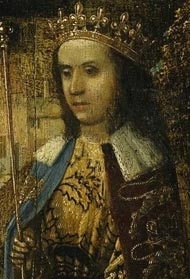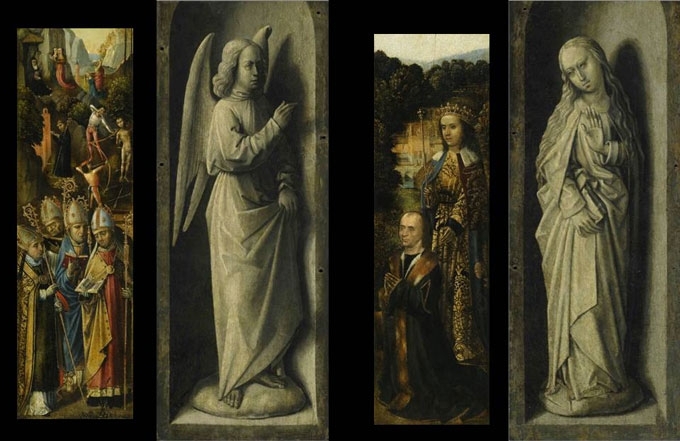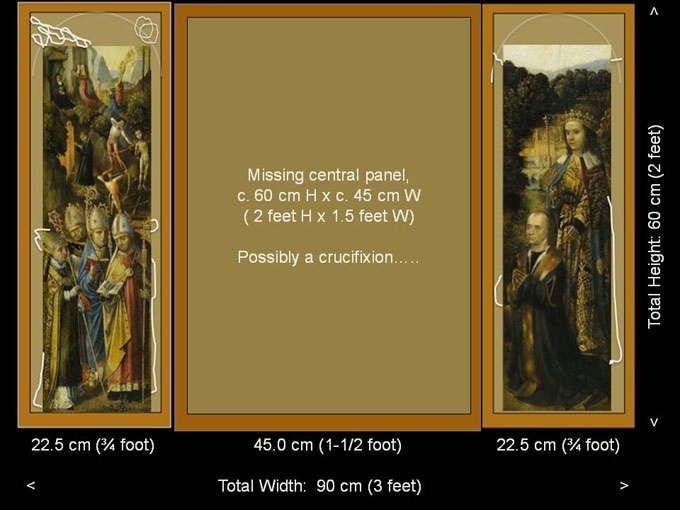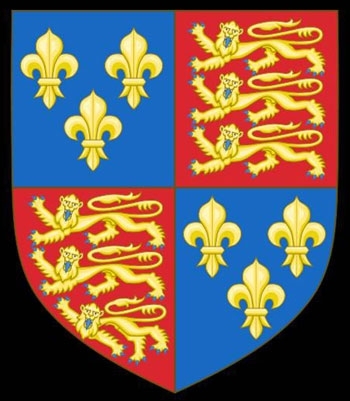Wings of a Triptych, by the Master of the St. Ursula Legend

Master of the St Ursula Legend
Wings of a Triptych
Bruges, Early Renaissance, c. 1490
Oil on panel
MCMA 2011.001
These two panels once served as the wings of a triptych, or three-paneled artwork, most likely commissioned by a private patron for personal devotion in a home. The center panel is now missing (Fig. 1). The wings are in a remarkable state of preservation and each is painted on both sides. When closed, they depict the Annunciation: the Archangel Gabriel on the left and the Virgin Mary on the right. These images are painted in grisaille, or shades of gray, to evoke the appearance of stone sculpture.

Master of the St. Ursula Legend (Flemish, c. 1475–1500), Left and Right Wings from an Altar; left Wing Depicting Saint Nicholas of Myra, Saint Eloi, Saint Blaise, and another Bishop Saint, as well as the Martyrdom of Saint Sebastian, the Beheading of Saint Barbara, the Temptation of Saint Anthony, and another Saint; right Wing Depicting British King Behind a Kneeling Donor; c. 1468–72. Oil on panel; left panel: 20 1/8 x 8 1/16 x 3/4 inches; right panel: 20 1/8 x 8 x 11/16 inches. Purchase with funds provided by the Christian A. Johnson Memorial Fund, 2011.001
When open, the shutters reveal two jewel-like compositions. In the foreground of the left panel stand four saints. On the far left is Saint Nicholas of Myra below whom are two of the children he is said to have resurrected from a barrel of brine. Next to the still unidentified bespectacled saint to his right is Saint Eloy, the patron saint of goldsmiths, who holds a hammer in his hidden left hand. At the right is Saint Blaise, the patron saint of the wool trade, with a carding comb tucked under his arm.

Figure 1
The landscape behind the four saints contains small scenes depicting the temptation of Saint Anthony, the beheading of Saint Barbara, the martyrdom of Saint Sebastian, and an as yet unidentified saint reading and holding a crosier.
On the right-hand panel is a portrait of the donor, who kneels in the foreground and wears a robe with over-long sleeves in the style of the period. Behind him stands a royal figure wearing a gold crown and holding a scepter. According to the existing pictorial custom, he is most likely a saint. In the distance, a figure on horseback crosses a bridge by a step-gabled house set in a deep wooded landscape.

Figure 2
Circumstantial evidence suggests that the royal figure depicted in the right panel may well be a rare portrait of the English King Henry VI (ruled 1422–1461 and 1470–1471). Not only does he resemble other royal portraits of Henry on coins and sculpture, but his ermine-trimmed robe depicts the royal arms––a quarterly partition of three golden lions on a red field and three golden fleurs-de-lis on a blue field. However, as the lions are reversed, the artist seems to have been unfamiliar with such heraldry details (Fig. 2).
Immediately after his death and continuing until about 1540, a cult of “Holy King Henry” was widespread in England and as far afield as France. Miracles attributed to Henry VI included any number of rescues of countrymen from painful deaths, so he makes an apt pairing with the martyred saints in the background of the left-hand panel. Such emphasis on martyrdom may suggest that the central panel depicted the Crucifixion.
Preliminary research indicates the panels are the work of the so-called “Master of the St. Ursula Legend,” an important artist active in Bruges, Flanders, in the second half of the fifteenth century, and who recently has been identified as Pieter Casinbroot (1430s–1504).
Richard Saunders
Director
Walter Cerf Distinguished College Professor
Pieter Broucke
Director of the Arts
Professor of History of Art and Architecture
Associate Curator of Ancient Art
